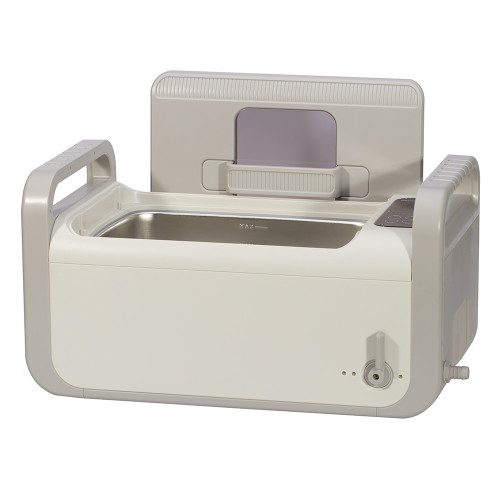
Ultrasonic Cleaner CD-4861 6 liter White
Ultrasonic cleaning is a process that uses ultrasound (usually from 20–400 kHz) and an appropriate cleaning solvent (sometimes ordinary tap water) to clean items.

Ultrasonic Cleaner CD-4861 6 liter White
Ultrasonic Cleaner Technology
Ultrasonic cleaning is a process that uses ultrasound (usually from 20–400 kHz) and an appropriate cleaning solvent (sometimes ordinary tap water) to clean items.
The ultrasonic cleaner can be used with just water, but use of a solvent appropriate for the item to be cleaned and the type of soiling present enhances the effect. Cleaning normally lasts between three and six minutes, but can also exceed 20 minutes, depending on the object to be cleaned.
Ultrasonic cleaning can be used for a wide range of work piece shapes, sizes and materials, and may not require the part to be disassembled prior to cleaning because the microscopic bubbles can reach every nook and cranny that no other cleaning method can do.
Ultrasonic cleaners are used to clean many different types of objects, including jewellery, lenses and other optical parts, watches, dental and surgical instruments, tools, coins, fountain pens, golf clubs, fishing reels, window blinds, firearms, car fuel injectors, musical instruments, industrial parts and electronic equipment.
They are used in many jewellery workshops, watchmakers’ establishments, and electronic repair workshops.
Ultrasonic cleaning uses cavitation bubbles induced by high frequency pressure (sound) waves to agitate a liquid. The agitation produces high forces on contaminants adhering to substrates like metals, plastics, glass, rubber, and ceramics.
This action also penetrates blind holes, cracks, and recesses. The intention is to thoroughly remove all traces of contamination tightly adhering or embedded onto solid surfaces.
Water or solvents can be used, depending on the type of contamination and the workpiece. Contaminants can include dust, dirt, oil, pigments, rust, grease, algae, fungus, bacteria, lime scale, polishing compounds, flux agents, fingerprints, soot wax and mold release agents, biological soil like blood, and so on.
Ultrasonic cleaning can be used for a wide range of workpiece shapes, sizes and materials, and may not require the part to be disassembled prior to cleaning because the microscopic bubbles can reach every nook and cranny that no other cleaning method can do. [source: Wikipedia
Uses:
1.Hospital and Dental Clinics
2.Optical Stores and Makers
3.Biology and Chemical Labs
4.Jewelry Store & Maker
5.Watch Service Shops
6.Mobile phone and Electronics Service Shops
7.Gun Clubs
8.Printing Shop
9Automotive Shop
10Hardware
11.Tattoo
12.Household
Etc.













